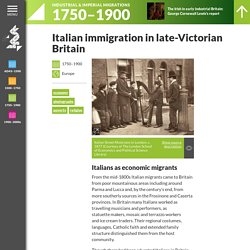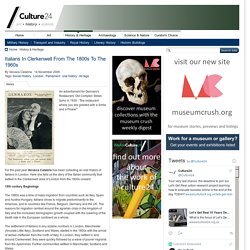

Philanthropist, Industrialist, and Merchant Banker: George Peabody, his life, his love and his legacy to the homeless poor of 19th Century Clerkenwell. - Museum of the Order of St John. Many would describe modern day Clerkenwell as a colourful, vibrant and trendy location, after all its an area peppered with fancy restaurants and bars, quirky pop up shops and boutique hotels.

I think it would be safe to conclude that Clerkenwell is definitely the place to be and be seen. But it would also be fair to say that over the years, Clerkenwell has had a somewhat chequered past. During the 19th century social conditions in Clerkenwell and indeed many other parts of London were pretty desperate for large sections of the community as swathes of Londoners were living in abject poverty, which is difficult to envisage considering that the 1850s were a time of real prosperity for Britain.
The ladies and the gentlemen: figures in the landscape. Before the photograph came the engraved print: etchings, mezzotints, aquatints and all the rest.

These were on the whole meant to be accurate views of their subjects, reliable likenesses of a person or a building. But it’s not quite the same as a photograph, is it? Looking at last week’s picture postcards I thought of the earlier, pre-photographic views of Kensington Gardens and of course Kensington Palace. Today in London penal history: escaped convicts fight constables, Saffron Hill, 1783. For centuries, from the early 1600s to the 1860s, England transported hundreds of thousands of convicts, political prisoners as well as prisoners of war from Scotland and Ireland to its overseas colonies in the Americas, and later to Australia.

“Initially based on the royal prerogative of mercy, and later under English Law, transportation was an alternative sentence imposed for a felony; it was typically imposed for offences for which death was deemed too severe. By 1670, as new felonies were defined, the option of being sentenced to transportation was allowed. Italy - The Napoleonic empire, 1804–14. Northern and central Italy Soon after Napoleon claimed the title of emperor in 1804, the Italian Republic became a kingdom, proclaimed on March 17, 1805.

Napoleon, as king of Italy, appointed his stepson, Eugène de Beauharnais, as viceroy and Antonio Aldini as secretary of state, forcing Melzi to step aside. Although Italian autonomy remained limited, Napoleon’s victories, which constantly increased the territory of the kingdom, provided some compensation. Italian immigration in late-Victorian Britain / Our Migration Story. The image of Italian street musicians is taken from John Thomson and Adolphe Smith (1877), Street Life in London.

Street Life in London (1877) consists of a series of articles by the radical journalist Adolphe Smith and the photographer John Thomson. The pieces are short but full of detail, based on interviews with a range of men and women who lived a precarious and marginal existence working on the streets of London, including flower-sellers, chimney-sweeps, shoe-blacks, chair-caners, musicians, dustmen and locksmiths. House of Borgia. Italo-Spanish Renaissance noble family Borgia ( BOR-zhə, BOR-jə,[2][3][4] Italian: [ˈbɔrdʒa]; Spanish and Aragonese: Borja [ˈboɾxa]; Valencian: Borja [ˈbɔɾdʒa]) was a Spanish-Aragonese noble family, which rose to prominence during the Italian Renaissance.[5] They were from Aragon, the surname being a toponymic from the town of Borja, then in the Crown of Aragon, in Spain.

The Borgias became prominent in ecclesiastical and political affairs in the 15th and 16th centuries, producing two popes: Alfons de Borja, who ruled as Pope Callixtus III during 1455–1458, and Rodrigo Lanzol Borgia, as Pope Alexander VI, during 1492–1503. Especially during the reign of Alexander VI, they were suspected of many crimes, including adultery, incest, simony, theft, bribery, and murder (especially murder by arsenic poisoning).[6] Because of their grasping for power, they made enemies of the Medici, the Sforza, and the Dominican friar Girolamo Savonarola, among others. History[edit] Early history[edit] 19th-century London. London-related events during the 19th century During the 19th century, London grew enormously to become a global city of immense importance.

It was the largest city in the world from about 1825,[1] the world's largest port, and the heart of international finance and trade.[2] Railways connecting London to the rest of Britain, as well as the London Underground, were built, as were roads, a modern sewer system and many famous sites. Overview[edit] Railway Map of London, 1899, from The Pocket Atlas and Guide to London. MoEML: London Aliens. ¶Introduction During the sixteenth century, London experienced a massive immigration of Dutch, Flemish, and even French Protestant refugees fleeing religious persecution in the European Low Countries.1 From 1567 to 1571, an estimated 18,000 people were executed for their religious beliefs in the Spanish Low Countries, following the Duke of Alva’s appointment to Captain-General (Finlay 67).

This persecution served to intensify the wave of immigrants escaping the Low Countries. These Protestant refugees created a noticeable alien2 community within London, greatly contributing to the economic innovations and industries that were developing at the time. Anti-Italianism. Anti-Italianism or Italophobia is a negative attitude regarding Italian people or people with Italian ancestry, often expressed through the use of prejudice, discrimination, or stereotypes.

Its opposite is Italophilia. In the United States[edit] Italians In Clerkenwell From The 1800s To The 1960s. An advertisment for Gennaro's Restaurant, Old Compton Street, Soho in 1930 - "the restaurant where you are greeted with a Smile and a Flower" For the past year Verusca Calabria has been collecting an oral history of Italians in London.

Here she tells us the story of the Italian community that settled in the Clerkenwell area of London from the 1800s onward. 19th century Beginnings The 1880s was a time of mass migration from countries such as Italy, Spain and Austria-Hungary. Italians chose to migrate predominantly to the Americas, and to countries like France, Belgium, Germany and the UK. Candida Martinelli's Italophile Site(London Italians) Italian Immigrants in London There were immigrants from Italy from 1000 onward, and possibly earlier: artists, artisans and musicians from Italy traveled around Europe and further, offering their services to the wealthy, or performing for the public, including in London. In the 1200s and 1300s, bankers, traders, and merchants of all kinds, mainly from the Genoa, Veneto and Lombardy regions, rich trading regions, set up offices in major trading cities and along trade routes, including in London.
In the late 1500s, the Venetian Giacomo Verelini was making glass in London. After his death, British businessmen monopolized glass-making in Britain, but imported Venetian glass makers to run the show. This is a link to an article on the Vauxhall Society site about this. Revolting Peasants: Southern Italy, Ireland, and Cartoons in Comparative Perspective, 1860–1882*
In the 1880s an English anthropologist travelling in the Mediterranean observed that the “people of Southern Italy seem born brigands […] very different are they from their grave, thoughtful brethren of the north. They form the element of national discord, the Irish of Italy.”Footnote 1 Ireland and southern Italy, or the mezzogiorno, regularly provided reverse images of modernity for an array of commentators in the nineteenth century. Stereotypes about indolence, violence, and dependency in geographically peripheral regions were widespread in British and Italian cities and contributed to how the national self-image and the other were imagined. Cartoons contributed significantly to this imaginary. From the 1840s, satirical magazines developed within the growing European media industry as a means of communication with a fresh immediacy, and peasants were often the subjects of ruthless ridicule.
Emigration Across the Atlantic: Irish, Italians and Swedes Compared, 1800–1950 – Brewminate. Examining scale of emigration, the reasons behind emigrants’ departure, the various origins and destinations, and the attitudes in sender and receiver states. By Dr. Irial GlynnLecturer in HistoryLeiden University Abstract Emigration across the Atlantic by Europeans during the 19th and 20th centuries, and especially during the so-called age of mass European migration from 1850 to 1914, forms a key part of Europe’s recent history. Italian Immigrants Arrive in Clerkenwell's Little Italy. Italian family bonds remained strong. After a couple of years with money jingling in their pockets, some of the men found themselves free from their Padroni. Some set off on the long gruelling journey back to their native towns or villages, bringing much needed funds for their empoverished families. Children Street Musicians and Entertainers Clerkenwell Italian. A letter to the Editor of The Times, 5 October 1876, page 8, reads: “Sir, – I desire to add my testimony in support of the facts given in your article upon Italian kidnappers, which appeared in The Times of to-day, As a result of close person inquiry, I am able to state that the number of Italian children at present kept in London and throughout the country for begging purposes is very large, and the sufferings they at times endure in the hands of their inhuman keepers can scarcely be described.
In a case which came under my notice two years ago, a girl of ten and two boys of eight and nine years of age were kept by a wretched Italian of the lowest class, in a miserable room out of Holborn. This man frequently beat them in the most horrible way if they returned with less money than he thought they should have obtained. More than one such result following from such treatment has come under my observation within the past five years. I am, Sir, your obedient servant, Living Conditions in Italian Community Little Italy in Clerkenwell London. Italians Arrive Clerkenwell London in the early 19th Century. In Search Of London's Little Italy. Hidden London. Italians in the United Kingdom. Italian Migration to Great Britain on JSTOR.
Heidi Kaufman, “1800-1900: Inside and Outside the Nineteenth-Century East End” The Digital Panopticon. MW48 : A summary history of immigration to Britain. Ghn essay bln lloyd1 website. Slums and Slumming in Late-Victorian London. Immigration and immigrants. East End of London. Drawing. Drawing. 'Sober but very immoral': What Victorian-era 'poverty maps' tell us about London today.
Supporters of Napoleon in England. The Whigs and Napoleon. Napoleon and the British. Brentford & Chiswick Local History Society. In Search Of London's Little Italy. Republicanism in the United Kingdom. (3) What were the beliefs of Napoleon Bonaparte? - Quora. What were the beliefs of Napoleon Bonaparte? - Quora. La Peregrina pearl. La Regente Pearl-Fifth Largest Pearl-Christies New York, Geneva. The Napoleonic Suppression of Italian Religious Orders and Sale of Their Property: Studies since 1960 on JSTOR. Italy, the Renaissance, and Religious Conflict. Marriage and the Kin Network: Evidence from a 19th-Century Italian Community.
Life in Italy during the 19th Century - Life in Italy. Italy - The Napoleonic empire, 1804–14. House of Borgia. The Adventure of the Six Napoleons. Supporters of Napoleon in England. READ: Italian Nationalism: A Point of View (article) Italian nationalism and napoleon. Lucrezia Borgia, Duchess of Ferrara. History of London's Little Italy, italian community in England. Lucrezia Borgia, Duchess of Ferrara. The Adventure of the Six Napoleons: Themes & Analysis - English Literature Class. ‘Almost the only free city in the world’: mapping out the French anarchist presence in London, late 1870s–1914 from A history of the French in London: liberty, equality, opportunity on JSTOR. My.access — University of Toronto Libraries Portal. My.access — University of Toronto Libraries Portal. My.access — University of Toronto Libraries Portal. A history of the French in London: liberty, equality, opportunity on JSTOR. My.access — University of Toronto Libraries Portal.
Anciennes et nouvelles aristocraties - Aristocratic Values and Elite Education in Britain and France - Éditions de la Maison des sciences de l’homme. The impact of the French Revolution in Britain. Kumar identity. Paris and London: A Tale of Two Radical Cities. Napoleon’s Surprising Popularity in Nineteenth-Century England. 19TH CENTURY FRENCH BONAPARTISM IN EUROPE. David A. Bell · Violets in Their Lapels: Bonapartism · LRB 23 June 2005. Napoleonic wars : London Remembers, Aiming to capture all memorials in London. Finding Napoleon in London at Wellington's Aspley House Museum. Bonapartism. The Hero as Houdini: Napoleon and 19th-century Bonapartism: Modern & Contemporary France: Vol 8, No 4.